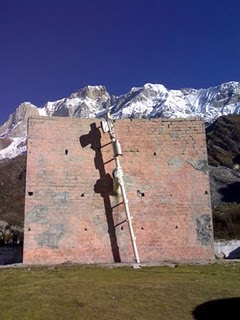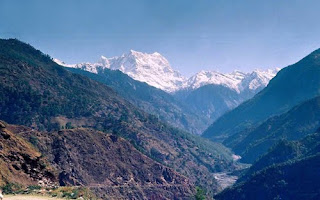It brought in a few thoughts... few serious thoughts about how we the people, Hindus view our faith. I am no one to teach it, but I am an observer...and as an observer I speak.
The story of Baghirathi wishing for the Ganges to come down to earth and give us life giving water almost came to life here. She came down roaring, crashing through the mountains, bringing to life the power of this mythology but with a difference. Lord Shiva didn't stand in the way to hold down her power in his matted locks. This is the power of the river, brilliant, intense, wrecking every little piece of man made atrocity in its path sending home the powerful message, YOU are a miserable small entity of life on this planet so stay that way.
It strangely reminded me of the Titanic, a grand ship that was built to defy nature and and nature consumed it in minutes with no survivors. We dug into the very foundation of the mountains and hoped to have things standing when they actually fell into the storming river like a bunch of miserable unstable pack of cards.
Then came the picture of Bhairava in my mind, the fierce form of Lord Shiva. As I watched the Times Now correspondent walk through the Kedarnath temple with his shoes on, flashing the camera at the main shrine which is strictly forbidden these days and closing his nose to the stench of decaying bodies around him, all I could visualize was Ughra Tandava.
Clearly the Ughra Tandava is not a pretty dance, its energetic in a stage littered with the dead, displaying the wrath of the God, expressing his fury when we miserable creatures hinder the ways of nature. I almost heard his cackling laughter. I wondered, I could feel the pulse of his fury, I could realize the intensity of the picture of truth, I could see the face of death as strongly as I saw the face of life and I could relate to the true meaning of the Kala Bhairava. How many of us have the capacity to withstand and love and worship this form? Isn't he so much better within the cage of a picture frame rather than as a demonstration of his capability!
And then came the horror of another possible truth that the people are probably totally unaware of and don't have the time to worry about. Amarnath Linga has disappeared into the waters, and the Kedarnath Linga is neck deep inside a pile of quick sand to a depth of 9 feet [Times Now coverage]. Was this an attempt of the great God to disappear into the earth leaving us to perish in this world that is slowly getting cheated off the sacred emblems that protect it? Are the great Gods leaving us to our peril? Is this the start of the ending of the great Kali Yuga? We have evolved too and our instincts yell out about such a fate a little too loudly these days.
If this is the beginning of the end, its a grand picture to watch, to observe the power of nature as it unfolds. The common thought is why kill the innocent people? I have not lost anyone personally but my heart sinks in sorrow for those who perished. And yet, I wonder that if I had to die, wouldn't it be a great place and a great way to die, at the shrine of the Lord of Kedarnath? I rather die overnight in the deluge next to the sacred emblem and hope for salvation from this existence rather than lie rotting like a vegetable in some god forsaken hospital looking at people waiting for me to die. And if the people were washed away by the great deluge, maybe it was Karma that applied on them. End of the day, no one is innocent and everyone who lives today is a sinner small or big. And of course, the truth is inevitable... we are born and therefore we will die.
And yet through all this hardship and survival, those who have been air lifted are just thanking their stars that while they went to Kedarnath and wished for petty things, the Lord of Destruction actually granted them another life. The only hope visible in this whole tragedy are the two sacred fresh Vilva leaves that continue to hold fort on the head of the sacred Linga of Kedarnath. Isn't it strange that the lightest and easily damageable Vilva leaf remains protected over the Lord's head while people lie dead around Him.
The Lord has spoken, expressing his discontent and wiping off those who had to go. The great army of Yama swept through the Himalayan valley picking up all those who perished along with the waters. The Great Mother Ganges, blessed the parched earth with her life giving waters to those who survived. To the great Gods I bow and thank them for this powerful message, for this great spectacle of life and death playing on the stage of the Himalayan foot hills.
Har Har Mahadev.












